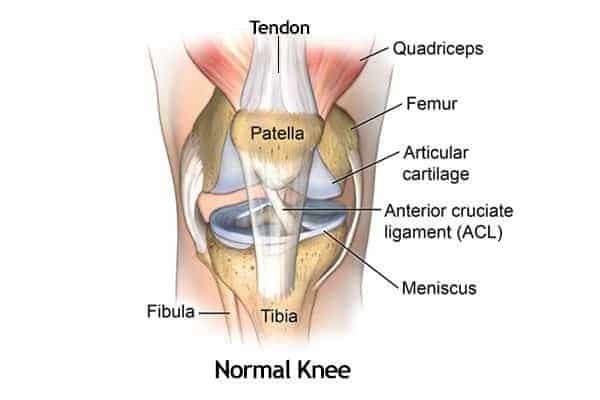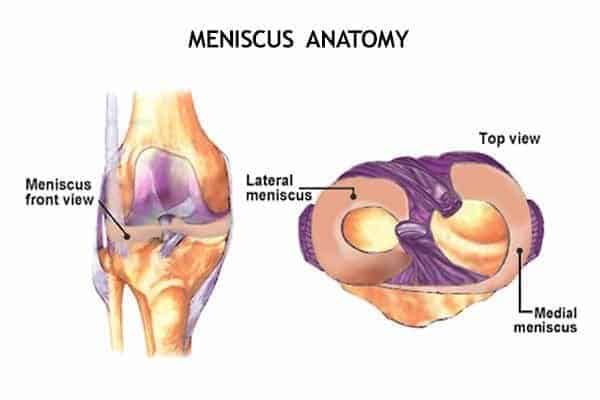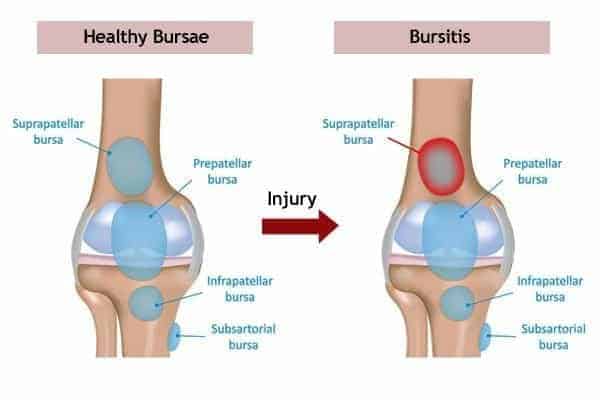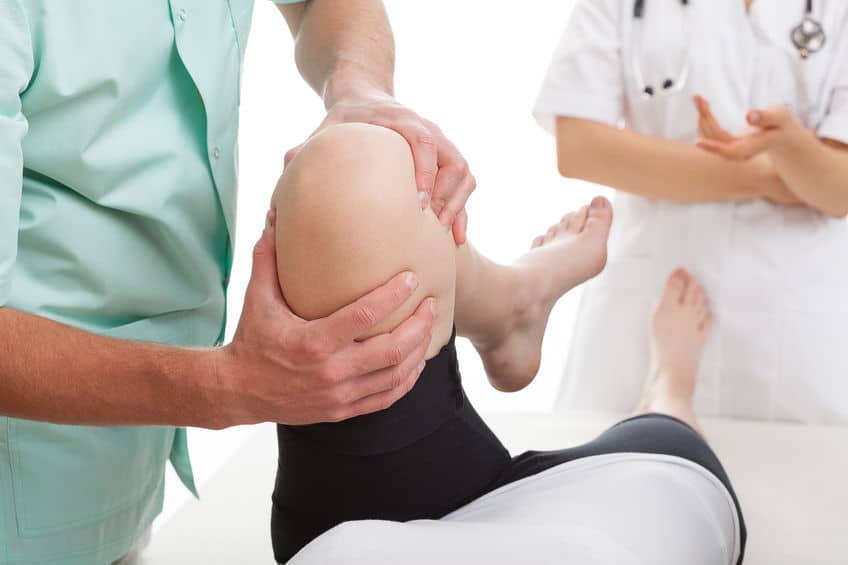Knee Therapy to Prevent Surgery Or Injections
CSC’s breakthrough knee therapy protocols can help you recover from knee discomfort & knee injuries without injections or surgery. Get your knees addressed at our award-winning center that combined chiropractic with physiotherapy. Contact one of our centers today for the recommended knee therapy & heal without surgery or injections today.
Knee therapy or care requires specialized skills and technology. Knee discomfort, knee arthritis, degenerative changes, and knee injuries are manageable without surgery or injections. The success rate of the knee therapy you get depends largely on the skills, knowledge, experience, and technologies that your therapy or care center uses. This article will provide in-depth information about the knee joint and knee issues causing aches, stiffness, and discomfort. Moreover, this article provides an in-depth look at knee therapy without surgery or injections.
Takeaway: 3 Key Insights
- Knee therapy via chiropractic, physiotherapy, and rehabilitation uses non‑invasive options aimed at joint function and structural health.
- An individualized approach includes assessment, gentle techniques, strength and movement training, and ongoing adjustment.
- Knee therapy can reduce the need for surgery or injections when integrated into a personalized care program.
Contact Us to Explore Knee Therapy
Contact us today to schedule a consultation and discover how our knee therapy program integrating chiropractic care in KL with physiotherapy, and rehabilitation can be tailored for your joint care.
Learn Why Understanding Your Knees Changes Everything
Knees function best when posture, rhythm, and balance align. Our Free Knee Health Talk in Kuala Lumpur offers easy-to-follow education that helps you build awareness and maintain joint stability in daily life.
What Are The Different Types Of Knee Therapies & Care
The type of knee therapy or the preferred knee care you get depends on the severity of the condition and your diagnosis. In general, there are several types of knee care. We have categorized knee therapy into two headings:
- Invasive care: Knee injections and knee surgery
- Non-invasive care: Physiotherapy, chiropractic, exercise, medication, bed rest, braces, and home care
Knee Care Through Injections & Injections Given As In Combination With Knee Therapy
Knee injections given as a stand-alone care or combined with knee therapy will worsen your knee! Knee injections are invasive procedures meant to reduce swelling and discomfort. Typically, they are provided for the osteoarthritic knee. There are several types of knee injections:
- PRP injections (platelet-rich plasma injections)
- Steroid injections (Corticosteroid injections)
- Stem cell injections
- Hyaluronic acid injections
Hyaluronic acid injections, stem cell injections, and PRP injections or platelet-rich plasma injections are common components of surgeons’ and hospitals’ knee therapy. The latest new and faddish injections benefit pharmaceutical companies and doctors more than it does for knee patients. Published studies in reputable journals question their beneficial! Each of these procedures comes with some risks and side effects. However, the risks and side effects of stem cell injections, PRP injections, or hyaluronic acid injections as not nearly as severe as steroid knee injections.
Cortisol is the main ingredient in corticosteroid injections (steroid Injections). Steroid injections (corticosteroids) help decrease the inflammatory processes resulting from arthritis or injuries. However, a recently published report in the Journal of Radiology Research states that corticosteroid (steroid injections) rapidly worsens the very condition it is meant to address! The lead researcher, Dr. Ali Guermazi, M.D., Ph.D. (professor at the world renounced Boston University School of Medicine), found progressive and rapid degenerative changes in joints and soft tissues requiring intensive surgical intervention. As such, steroid injections of the knee should stop altogether and not be part of any knee therapy program.
Dr. Ali and his collogues relates six common side-effects with corticosteroid knee injections as stand alone or in combination with knee therapy:
- Rapidly progressive arthritic changes in the knee (osteoarthritis)
- Rapid loss of knee joint space due to rapid and severe degeneration of the meniscus
- Severe and rapid loss of cartilage
- Death of bone tissue (osteonecrosis)
- Rapid onset of bone loss at the site of injections (osteoporosis)
- Stress fractures
Knee therapy or care given or added through steroid injections is now proven to be more harmful than beneficial. According to Dr. Ali, the rapid and progressive degenerative and arthritic changes due to steroids may get so severe that patients will have to undergo knee replacement surgery!
Knee Care Through Surgery
According to the Arthritis Foundation, knee surgery may be recommended when conservative knee care does not lead to desired results. Generally, there are three types of surgical care for the knee:
- Arthroscopic knee surgery
- TKR (Total Knee Replacement)
- Osteotomy
A report from a reputable group of Ph.D. orthopedic surgeons published in the New England Journal of Medicine blasts knee care by arthroscopic surgery as no better than a fake or sham surgical procedure. The report is based on double-blind trials of 146 patients. It is the first randomized, multicenter, sham-controlled study to compare the outcome of knee surgery 12 months post the arthroscopic procedure. As such, they encourage a focused and targeted system of knee therapy that fixes and repairs the knee without surgery. These doctors were shocked to find no difference between the fake surgery and the arthroscopic knee surgery! You can read this report here.
Osteotomy and TKR, or total knee replacement, are common surgical procedures when doctors don’t want the patient to have knee therapy or when conservative care fails. Both are knee care procedures for severely degenerated, uncomfortable, and arthritic knee patients. As we mentioned earlier, TKR and osteotomy are also common in patients who have had steroid injections. Moreover, we suspect that the arthroscopic procedure is another leading factor in TKR or osteotomy knee surgeries. Therefore, if you or someone you know suffers from knee discomfort, tell them about our non-invasive knee therapy program. Our knee care will produce better results without injections or surgery. Most importantly, they get better, without the risks of any side effects!
Focused Non-Surgical Knee Therapy Program In Malaysia
Successful knee therapy occurs when your doctor or therapist targets the actual cause of your discomfort. The knee joint is a complex entity comprised of multiple soft tissues (ligaments, tendons, and muscles), cartilaginous structures (the articular cartilage and the menisci), as well as the 14 bursae. In addition, degenerative changes (wear and tear), injury, or underlying health conditions are known factors implicated in knee discomfort.
Knee discomfort is a common condition in kids, young adults, and the elderly. However, successful knee therapy and care that repairs the cause aren’t that common. Unfortunately, most doctors and therapists provide palliative care. Palliative care can be of help. However, to recover fully, you will need targeted care. In other words, knee therapy and knee care need to be comprehensive to target, fix, and repair the damaged tissues or structures without injections or surgery.
Medication, braces, exercise, rest, injections, surgery, or braces have failed most as they lack specificity. Chiropractic Specialty Center® provides the most productive knee care because we assess and target the actual damage. This article gives you an overview of the function and structures of the various knee joints and soft tissues. We will cover the knee therapy again after discussing the knee joint, its function, and its structures.
What Is The Function Of The Knee Joint?
The primary function of the knee joint is to bear the body’s weight and to provide mobility. The bending, extending, and straightening of the knee joint is accomplished through a series of interconnecting soft tissues. Mules, ligaments, tendons, cartilage, and meniscus, along with the four primary bones of the knee, achieve movements at the knee joint.
Knee discomfort will result with overuse issues or when one or more of these bones are not properly aligned. First, let’s look at the knee joint (bones), ligaments, tendons, cartilage, and menisci. A closer look will help you understand the importance of successful knee care.
Primary Structures Of The Knee Joint
The primary structures in your knee joint include weight-bearing bones, non-weight-bearing bones, ligaments, tendons, cartilage, menisci, and bursae.
The Two Weight-Bearing Bones Of The Knee
Your knee joint has two weight-bearing bones, the femur or thighbone and the tibia or the shinbone. The femur or the thighbone forms the upper portion of the knee joint. The femur also forms the hip joint. Patients who suffer from knee discomfort should also have their hip joint assessed. Yes, hip problems can also cause knee discomfort. The tibia or the shinbone connects to the femur. It is the lower weight-bearing bone of the knee. Successful knee care of the weight-bearing joint is critical to recovery. Your knee therapy must focus on stabilizing the weight-bearing bones and joints of the knees.
The two non-weight-bearing Bones Of The Knee
The non-weight-bearing knee joints are just as important in successful knee care. The patella and the fibula are the non-weight-bearing bones of the knee joint. Their primary function is for muscle attachment that enabling movements at the knee joint or the ankle joint. The patella is the largest sesamoid bone in the body. We have provided a brief description of a sesamoid bone under tendons. Although these two bones are non-weight-bearing, they provide essential functions.
Knee therapy programs that fail to address the patella and fibula are doomed to fail. They fail because two of the strongest muscles in your body have an attachment to the patella and fibula. The hamstrings and quadriceps are two of the largest and strongest muscles. Tensions, spasms, and injuries impact these muscles as well as the patella and fibula. As such, our expert non-surgical clinical teams pay extra attention to the patella and fibula during your knee therapy sessions.
Ligaments Of The Knee Joint

Before we get started on knee ligaments, we would like to point out that our knee therapy program can successfully fix and repair ligament damage to any joint, including the knee. By definition, ligaments are the tightly bound fibrous bands of tissue that connect bones, forming joints. The four ligaments of the knee that create the knee joint are:
- Medial collateral ligament (MCL)
- Lateral collateral ligament (LCL)
- Anterior Cruciate ligament (ACL)
- A posterior cruciate ligament (PCL)
The medial and lateral collateral ligaments (MCL and LCL) connect to the inner and outer parts of the knee, respectively. Collectively, they provide the knee with side-to-side stability. The ACL and PCL are ligaments situated inside your knee joint. The anterior cruciate ligament (ACL) and the posterior cruciate ligament (PCL) provide your knees with front-to-back stability as well as stability during rotational movements. Stability assessments of these four ligaments are essential parts of an successful knee care program. Keep in mind that ligamentous damage is repairable without surgery. Our knee therapy program can help you recover from damaged and injured ligaments.
What Are The Primary Tendons Of The Knee?
The general rule for tendons is that they connect muscles to bones. And yes, we can fix tendons with targeted non-surgical knee therapy. However, to recover from tendonitis & tendon tears, you need specialized methods and therapy devices. We are the leading non-surgical knee therapy center in Malaysia. Now, let’s get back to the tendons of the knee joint.
Tendons are essential components of a successful knee care program. Your knee joint has two primary tendons:
- Quadriceps tendon
- Patellar tendon
The quadriceps tendon attaches the quadriceps muscles (rectus femoris) to the kneecap (patella), enabling knee extension. The patellar tendon is exceptional as it connects the patella to the tibia. Therefore, realistically speaking, a ligament classification is less confusing. However, it is classified as a tendon because the bony attachment is to a sesamoid bone (patella or kneecap). Sesamoid bones are small bones found in hands, feet, or knees. They develop within tendons that traverse (pass over) angular structures. As mentioned, the patellar is the largest of the sesamoid bones. Therefore, the tissue connecting the patella to the leg bone is a tendon.
Joint Cartilage Within Your Knee
The joint cartilage, or the articular cartilage, is the source of discomfort in the knee. Knee joint cartilage is a firm but somewhat rubbery tissue covering the ends of knee bones and the bottom surface of the kneecap (patella). Together with the menisci, they provide shock absorption. Successful knee therapy must consider the cartilaginous health of the knee joint. Abnormal weight-bearing and injuries lead to degenerative changes in the cartilage and eventual discomfort. Therefore, accurate diagnosis and targeted care of the knee cartilage are essential parts of reliable knee care.
The Menisci Of The Knee

The knee joint has two crescent-shaped fibro-cartilaginous structures known as menisci (plural for meniscus), the medial and lateral meniscus. The bottom of the menisci (medial and lateral meniscus) attaches to the tibia or leg bone. The upper portions of the menisci are curved inwards (concave). The concave surface of the menisci forms the articular surface or point for the femoral condyle or the knee end of the thighbone. Meniscal injury is a common source of knee discomfort. Even the slightest damage to the menisci requires care. Differing from what most may tell you, a meniscal injury can heal with successful knee care programs that address the tears holistically.
The Bursae Of The Knee Joint

A bursa is a fluid-filled sac. Their primary function is cushioning of soft tissues near the skin or bony surfaces, such as joints. In total, there are 14 bursae (plural for bursa) around the knee. Knee therapy is incomplete without a thorough assessment of all the bursae in the proximity of the knee joint. Below is the list of bursae around the knee. We have divided them into categories for simplicity:
A bursa is a fluid-filled sac. Their primary function is cushioning of soft tissues near the skin or bony surfaces, such as joints. In total, there are 14 bursae (plural for bursa) around the knee. Below is the list of bursae around the knee. We have divided them into categories for simplicity:
Knee bursae in the anterior compartment:
- Subcutaneous bursa
- Suprapatellar bursa
- Prepatellar bursa
- The deep infrapatellar bursa
- Pretibial bursa
Knee bursae along the outer or lateral compartment of the knee joint:
- Fibulopopliteal bursa
- Lateral gastrocnemius bursa
- Fibulopopliteal bursa
- Subpopliteal bursa or recess
Bursae along the inner part or medial compartment of the knee joint:
- Subtendinous or the medial gastrocnemius bursa
- Anserine bursa
- Semimembranosus bursa
- Bursa between the semimembranosus and semitendinosus tendons (a rarely found bursa in most) Semimembranosa bursa
Knee bursitis is relatively common in an injured knee. Bursitis can be self-limiting if the injury is minimal. However, if your discomfort persists for more than one week, you need our non-surgical holistic expert teams of chiropractors and physiotherapists. Bursitis of the knee is manageable without injections. Contact us today for focused knee therapy that gives you lasting comfort.
Opt For Holistic Knee Care That Repairs The Actual Damage
Chiropractic Specialty Center® provides highly efficient, comprehensive knee care. Our successes are the result of our in-depth understanding of the knee joint and issues that cause discomfort. If you suffer from knee discomfort or have had an injury, call or visit us. Talk to us about non-invasive options before opting for surgery or injections.
We will evaluate the muscles, ligaments, meniscus, and joints of the knee to identify weakness and malfunction. Our care starts when we have identified the cause of discomfort. With accurate diagnosis, our clinical physiotherapists and chiropractors will work with you collaboratively. In addition to the manual procedures, they will use some sophisticated therapy devices. Their goal is to get you healthy as soon as possible. Most importantly, our knee therapy will get you better without surgery or injections.
Productive Knee Therapy At Chiropractic Specialty Center®
Our clinical team’s goal is to provide you with productive knee care that repairs the damage. The first step is a critical step in which we assess and diagnose your knee discomfort or injury. The diagnosis part is the hardest; if it goes well, so does the therapy. For an accurate diagnosis, we may need an X-ray or even an MRI. Regardless of the severity of your condition, we will have a non-surgical option available for you.
When our team starts their care, you can rest assured that they will deliver the promised results. We have over a 95% success rate when it comes to knee therapy and care. Our achievements are the reason why knee sufferers seek our advice. So, if you have an injured knee or an uncomfortable knee joint, we can help.
Call us today and get the most holistic knee therapy. Chiropractic Specialty Center® in Kuala Lumpur offers targeted knee care through non-invasive methods and breakthrough therapy devices & technology that repairs knee damage without injections or surgery. So don’t delay; contact us today and get the recommended knee therapy, heal without surgery in Kuala Lumpur today.
Knee Surgery V.S. Our Productive Knee Therapy. Which Is Better & Why?
Remember, many still have discomfort after surgery. The majority of patients we have addressed have had surgery or are strongly encouraged to have surgery. In both these cases, improvements achieved were non-surgical.
Chiropractic Specialty Centers® have teams of physiotherapists and chiropractors to address even the most uncomfortable knee condition. We have helped many whose knee surgery made worse. Unfortunately, far too many are pushed into getting the useless arthroscopic surgery or talked into getting the TKR (Total Knee Replacement Surgery) way too early. If your surgeon is recommending surgery or steroid injections, visit us first. Knee surgery or steroid injections can have some limited improvement, but most will still suffer from discomfort.
Get your discomfort healed without cutting or taking harmful substances. Visit one of our centers today to start your recovery. Don’t let knee discomfort bog you down. Our productive knee therapy for knee discomfort can help you live a healthy, active life again.
We hope this article helps provide some information on knee therapy, knee discomfort & knee surgery. CSC offers productive knee therapy & care that enables you to avoid surgery or inactions. Contact one of our centers to get more information about our knee therapy program that repairs the cause of your knee discomfort without injections or surgery today.
Author: Yama Zafer, D.C. – Knee Therapy to Avoid Surgery & Injections
Yama Zafer, D.C., holds dual educational backgrounds in physiotherapy and chiropractic from Cleveland Chiropractic University in Kansas City and brings nearly three decades of physiotherapy and chiropractic experience. Read more about Y. Zafer.
Peer‑Reviewed References
- van der Esch M, et al. “Effectiveness of exercise therapy for knee osteoarthritis.” Ann Rheum Dis. 2015;74(8):1513–1519.
- Bennell KL, et al. “Physiotherapy management of knee osteoarthritis.” Clin Rheumatol. 2017;36(9):2103–2112.
- Brosseau L, et al. “Combined chiropractic and physiotherapy for knee osteoarthritis: a randomized trial.” J Manipulative Physiol Ther. 2019;42(2):110–117.
- Wang Y, et al. “Non‑surgical management of knee osteoarthritis.” BMJ. 2020;369:m1035.
- Hochberg MC, et al. “American College of Rheumatology guidelines for knee osteoarthritis.” Arthritis Care Res. 2022;74(4):550–558.
- Oliveira CB, et al. “Exercise for knee osteoarthritis: systematic review.” Cochrane Database Syst Rev. 2021;4:CD007963.
- Bennell KL, Hinman RS. “Exercise as first‑line management for knee osteoarthritis.” Best Pract Res Clin Rheumatol. 2022;36(2):101748.
Last Updated
Last updated: June 23, 2025 • Knee Therapy to Prevent Surgery or Injections


